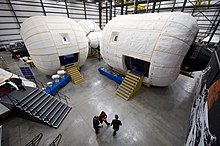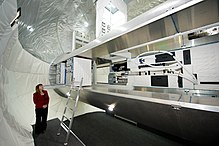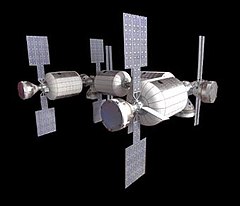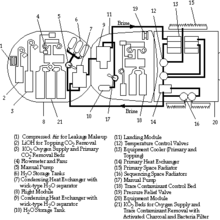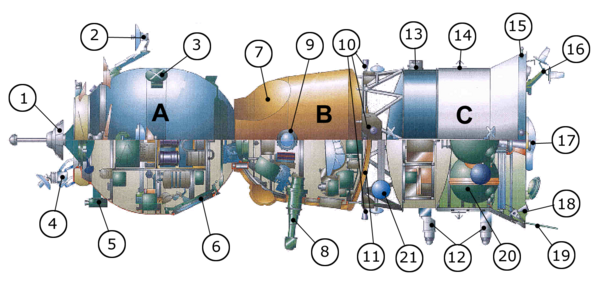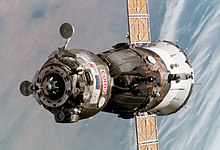 | |
| Private | |
| Industry | Aerospace |
| Founded | 1999 |
| Founder | Robert Bigelow (Founder and President) |
| Headquarters |
,
United States
|
Key people
| Robert Bigelow, Blair Bigelow |
| Products | Orbital facilities, commercial space stations |
Number of employees
| 150 (Dec 2018) |
| Website | bigelowaerospace |
Bigelow Aerospace is an American space technology startup company based in North Las Vegas, Nevada, that manufactures and develops expandable space station modules. Bigelow Aerospace was founded by Robert Bigelow in 1998 and is funded in large part by the profit Bigelow gained through his ownership of the hotel chain, Budget Suites of America.
By 2013, Bigelow had invested US$250 million in the company. Bigelow has stated on multiple occasions that he is prepared to fund Bigelow Aerospace with about US$500 million through 2015 in order to achieve launch of full-scale hardware.
Bigelow Aerospace has stated they intend to create a modular set of space habitats for creating or expanding space stations.
History
NASA's design for the now-canceled TransHab module
Bigelow originally licensed the multi-layer, expandable space module technology from NASA in 2000 after Congress canceled the International Space Station (ISS) TransHab project following delays and budget constraints in the late 1990s.
Bigelow has three Space Act agreements whereby Bigelow Aerospace
is the sole commercializer of several of NASA's key expandable module
technologies.
Bigelow continued to develop the technology for a decade,
redesigning the module fabric layers—including adding proprietary
extensions of Vectran
shield fabric, "a double-strength variant of Kevlar"—and developing a
family of uncrewed and crewed expandable spacecraft in a variety of
sizes. Bigelow invested US$75 million in proprietary extensions to the NASA technology by mid-2006, and $180 million into the technology by 2010.
By 2010, Robert Bigelow had invested US$180 million in the company, which by 2013 had grown to US$250 million of his personal fortune.
Bigelow stated on multiple occasions that he was prepared to fund
Bigelow Aerospace with up to about US$500 million through 2015 in order
to achieve launch of full-scale hardware.
In early 2010, NASA came full circle to once again investigate
"making inflatable space-station modules to make roomier, lighter,
cheaper-to-launch spacecraft" by announcing plans in its budget proposal
released February 22, 2010. NASA considered connecting a Bigelow
expandable craft to the ISS for safety, life support, radiation
shielding, thermal control and communications verification testing for the next three years," and in December 2012, signed a $17.8 million contract with Bigelow to develop the Bigelow Expandable Activity Module (BEAM), then projected to fly in 2015.
The module was berthed to the International Space Station on April 16,
2016, and was inflated on May 28, 2016. As of April, 2019 it remains at
the station.
Since early on, Bigelow has been intent on "pursuing markets for a
variety of users including biotech and pharmaceutical companies and
university research, entertainment applications and government military
and civil users." The business model includes "'leasing out' small
space stations or habitats made of one or more B330 inflatable modules
to different research communities or corporations.". Despite these broad plans for space commercialization, the space tourism destination and space hotel monikers were frequently used by many media outlets following the 2006/2007 launches of Genesis I and Genesis II.
Robert Bigelow has been explicit that he is aiming to do business in
space in a new way, with "low cost and rapid turnaround, contrary to
traditional NASA ISS and Space Shuttle operations and bureaucracy."
In October 2010, Bigelow announced that it had agreements with six sovereign nations to utilize on-orbit facilities of the commercial space station: United Kingdom, Netherlands, Australia, Singapore, Japan and Sweden. In February 2011, Dubai of the United Arab Emirates became the seventh nation to have signed on.
In 2011, Bigelow employed an in-house team of model makers, coming from the film and architecture
industries, to make detailed models of their space habitats and space
stations. Scale models were sent to "potential customers, including
governments and corporations, as a reminder of the possibilities."
Reportedly due to delays in launch capability to transport humans
to low Earth orbit, Bigelow dramatically reduced staff in late
September 2011, because crew transportation would become available
"years after the first B330 could be ready", laying off 40 of their 90 employees.
In late March 2012 Bigelow began increasing staff levels once again. By April 2013, Bigelow was saying that they would have B330 modules ready to go to space
by the time that commercial passenger spacecraft were available to
ferry their customers to the dual-BA330 Alpha space station—expected in
2017—and that Bigelow was ready to enter into contracts with customers.
Further staff reductions occurred at the start of 2016, estimated
by industry sources to be between 30 and 50 people of 150 employed at
the time of the layoffs. This came after the company advertised more
than 100 jobs in 2015 at both its North Las Vegas headquarters and its
newly established propulsion department in Huntsville, Alabama. As part of its reduction in workforce, the company closed the Huntsville facility.
In February 2018, the company announced the formation of a new
subsidiary, Bigelow Space Operations, to handle operational aspects of
marketing and operating space stations in low Earth orbit.
Module design and business plans
A full-scale mockup of Bigelow Aerospace's Space Station Alpha inside their facility in Nevada.
Expandable module design overview
NASA Deputy Administrator Lori Garver views the inside of a full-scale mockup of Bigelow Aerospace's Space Station Alpha.
Bigelow Aerospace anticipates that its inflatable modules will be more durable than rigid modules. This is partially due to the company's use of several layers of vectran, a material twice as strong as kevlar, and also because, in theory, flexible walls should be able to sustain micrometeoroid
impacts better than rigid walls. In ground-based testing,
micrometeoroids capable of puncturing standard ISS module materials
penetrated only about halfway through the Bigelow skin. Operations
director Mike Gold commented that Bigelow modules also wouldn't suffer
from the same local shattering problems likely with metallic modules.
This could provide as much as 24 hours to remedy punctures in
comparison to the more serious results of standard ISS skin
micrometeoroid damage.
Expected uses for Bigelow Aerospace's expandable modules include microgravity
research and development and space manufacturing. Other potential uses
include variable-gravity research—for gravity gradients above
microgravity including moon (0.16 g) and Mars (0.38 g) gravity research; space tourism—such as modules for orbital hotels; and space transportation—such as components in spaceships for Moon or Mars manned missions.
Business plans
As of October 2015
the Bigelow Aerospace website shows several pricing schemes including
$51.25 million for 60 days on a B330 space station. That price covers
everything including transport, training, and consumables. For $25
million Bigelow Aerospace customers can lease a third of a B330 habitat,
roughly 110 cubic meters, for a period of 60 days.
In 2010, Bigelow proposed conceptual designs for expandable
habitats that would be substantially larger than the B330, previously
its largest at 330 cubic meters (11,700 cu ft) habitat volume.
Contingent on NASA going forward with a super heavy lifter,
the proposed concept would include "expandable habitats offering 2,100
cubic meters [74,000 cu ft] of volume — nearly twice the capacity
available on the International Space Station", and another providing 3,240 cubic meters (114,400 cu ft).
In 2010, Bigelow Aerospace began building a large production facility in North Las Vegas, Nevada to produce the space modules. The 181,000 square feet (16,800 m2) facility will include three production lines for three distinct spacecraft, doubling the amount of floor space at Bigelow, and transitioning the focus from research and development, with an existing workforce of 115, to production. Bigelow expected to hire approximately 1,200 new employees to staff the plant, with production commencing in early 2012.
In 2013, during execution of the contract to build the Bigelow Expandable Activity Module for the International Space Station,
Robert Bigelow indicated that his company manufactures about 50 percent
of product content in-house, while subcontracting out the remainder.
In March 2013, Bigelow signed an agreement with NASA to act as "the central link between NASA and dozens of private companies that want to play a role in the creation of a new economy – a space economy, including proposals far more complex than mere space tourism: research, manufacturing, medicine and agriculture. The agreement calls for Bigelow to liaise between NASA and the private sector to see how [the U.S.] government and industry could help each other."
The first deliverable on that contract, a "report which
identifies companies that want to be a part of this effort, as well as
potential customers", was delivered by Bigelow to NASA in May 2013.
Module construction and deployment timeline
On
July 12, 2006, and June 28, 2007, Bigelow launched the Genesis I and II
modules, respectively. In mid-2008, Bigelow Aerospace completed the Galaxy module but did not launch it due to rising launch costs and the ability to substantially validate the new Galaxy technologies terrestrially, particularly after the successful two Genesis launches in 2006 and 2007. It was tested on the ground at its North Las Vegas facility instead.
As of 2014 Bigelow had reserved a 2015 launch on SpaceX's Falcon 9 rocket,
but did not announce the payload. The Falcon 9 would have been capable
of launching a Sundancer module, but not a B330 module. Bigelow also
talked with Lockheed Martin regarding potential launches on the Atlas V-401 rocket. No launch took place in 2015, although in April 2016 Bigelow Aerospace remained on SpaceX's list of future launch customers.
On April 8, 2016 the SpaceX CRS-8
mission launched BEAM to the ISS; on April 11, 2016, Bigelow and United
Launch Alliance announced that an Atlas V-552 rocket had been booked
for a flight in 2020 to deliver a B330 habitat to low-Earth orbit.
Note: Dates of upcoming launches are proposed and are subject to change. Cancelled projects are in italics.
| Module Type | Module Names | Volume | Flight Date | Launch Vehicle | Status |
|---|---|---|---|---|---|
| Genesis Pathfinder | Genesis I | 11.5 m3 (410 cu ft) | July 12, 2006, 14:53 UTC | Dnepr | Launch successful, on orbit |
| Genesis Pathfinder | Genesis II | 11.5 m3 (410 cu ft) | June 28, 2007, 15:02 UTC | Dnepr | Launch successful, on orbit |
| Galaxy | Galaxy | 16.7 m3 (590 cu ft) | Cancelled | N/A | Launch cancelled, tests on ground |
| Sundancer | Unknown | 180 m3 (6,400 cu ft) | Cancelled | Unknown | Launch cancelled, replaced by B330 |
| BEAM | Bigelow Expandable Activity Module (BEAM) | 16 m3 (565 cu ft) | April 8, 2016, 20:43 UTC | SpaceX Dragon | Built under a $17.8 million NASA contract. |
| B330 | Nautilus | 330 m3 (11,700 cu ft) | 2020 | Unknown | In design; mockup built by 2015; public goal was to have two completed and ready to launch by the end of 2017 |
| BA 2100 | Olympus | 2,100 m3 (74,200 cu ft) | Unknown | Unknown | Proposed, Mockup built by 2015 though too large for any rocket currently flying |
Expandable habitat modules
Genesis I
Genesis I, the first Bigelow Aerospace module to be placed into orbit
On July 12, 2006, Genesis I launched on a Dnepr booster from Dombarovskiy Cosmodrome in Orenburg Oblast, Russia. The launch was conducted by Bigelow and ISC Kosmotras.
Despite ground-side difficulties during launch, the spacecraft
performed as expected upon reaching orbit, inflating, deploying solar
arrays and starting internal systems.
The mission is planned to last for five years and include extensive
observation of the craft's performance including testing
packing/deployment procedures and resistance to radiation and space
debris, among other space hazards and conditions. Mike Gold, corporate
counsel for Bigelow Aerospace, stated in relation to this mission and
the next, "Our motto at Bigelow Aerospace is 'fly early and often'.
Regardless of the results of Genesis 1, we will launch a follow-up
mission rapidly." As of July 2015, the vehicle remains in orbit.
Genesis II
On June 28, 2007, Genesis II launched on another Dnepr (a converted SS-18 ICBM) from Dombarovskiy Cosmodrome in Orenburg Oblast, Russia. Launched at 8:02 a.m. PDT Genesis II was inserted into orbit at 8:16 a.m. PDT at an inclination of 64 degrees.
Although Genesis I and Genesis II are identical in size and
similar in appearance there are several notable differences. Firstly,
Genesis I contains 13 video cameras whereas Genesis II contains 22.
Secondly, Genesis II includes a suite of additional sensors and avionics
that are not present in Genesis I.
The orbital life is estimated to be 12 years, with a gradually
decaying orbit resulting in re-entry into Earth's atmosphere and burn-up
expected. As of July 2015, the vehicle remains in orbit.
- Fly your stuff program
Bigelow Aerospace ran a Fly Your Stuff program for the Genesis II launch. The cost to launch pictures or small items was around US$300.
Bigelow photographed each item with internal cameras as the items
floated inside the craft, displaying them on the company website.
The first image of the interior of Genesis II appeared on the
company's website on June 29, 2007. Some of the pictures and other items
placed aboard Genesis II as part of the Fly Your Stuff program are
clearly visible. Another interior image, apparently taken with more of
the spacecraft's internal lights activated, was posted on July 2, 2007.
Articles from the Fly Your Stuff program are also visible in this image.
Test items, supplied by Bigelow Aerospace employees, were sent
into orbit on Genesis I. No new images of items floating inside Genesis I
have been released since shortly after the launch and initial
activation of the spacecraft due to problems with a computer which
controls several of the internal cameras.
Sundancer
The third planned Bigelow launch, Sundancer,
was to be equipped with full life support systems, attitude control,
orbital maneuvering systems, and would have been capable of reboost and
deorbit burns. Like the Genesis pathfinders, Sundancer
the outer surface would have been compacted around its central core,
with air expanding it to its full size after entering orbit. After
expansion, the module would have measured 8.7 metres (29 ft) in length
and 6.3 metres (21 ft) in diameter, with 180 cubic metres (6,400 cu ft)
of interior volume. Unlike previous Bigelow craft, it was planned to have three observation windows. As of September 2009, SpaceX had been contracted to provide a Falcon 9 vehicle for launch of a Bigelow payload in 2011.
In July 2011, Bigelow announced that they will cease development on the Sundancer and instead focus their efforts on the B330.
Bigelow Expandable Activity Module for the ISS
Full-scale mock-up of an expanded BEAM (January 16, 2013)
In December 2012, Bigelow began development work on the Bigelow Expandable Activity Module (BEAM) under a $17.8 million NASA contract. After a number of delays, BEAM was transported to ISS arriving on April 10, 2016, inside the unpressurized cargo trunk of a SpaceX Dragon during the SpaceX CRS-8 cargo mission.
The mission tested the BEAM module's structural integrity, leak rate,
radiation dosage and temperature changes over a two-year-long mission. At the end of BEAM's mission, the module was planned to be removed from the ISS and burn up during reentry.
In October 2017, it was announced that the module would stay attached
to the ISS for at least three more years, with options for two further
one-year extensions.
B330
The B330 is a full-scale production module weighing approximately 50,000 pounds (23,000 kg), with dimensions of approximately 45 feet (14 m) in length and 22 ft (6.7 m) in diameter when expanded. Previous names for the B330 were the BA 330 and the Nautilus.
Bigelow has partnered with United Launch Alliance with the goal of launching a B330 module to orbit in 2020, potentially as an addition to the International Space Station. The two companies have also proposed launching a B330 to low lunar orbit in 2022 to serve as a lunar depot. The first B330 launch was originally planned to be launched aboard an Atlas V rocket, but ULA stated in October 2017 that its in-development Vulcan rocket was the only launch vehicle available with the performance and fairing capacity to carry the module.
BA 2100 concept module
The BA 2100, or Olympus module, is a concept module that would require a heavy-lift launcher and would place in orbit the complete infrastructure of a 2,100-cubic-meter (74,000 cu ft) habitat, over six times as large as the B330. As of October 2010,
initial estimates put the vehicle mass between 70-90 tonnes, with a
diameter of approximately 41 feet (12 m). The concept model shows
docking ports at both ends.
Delays in launch capability
As
a result of delays in launch capability to transport humans to the
Bigelow habitats, Bigelow "laid off some 40 of its 90 employees" in late
September 2011. Bigelow had expected human launch capability by 2014
or 2015 but "the prospect of domestic crew transportation of any kind is
apparently going to occur years after the first B330 could be ready.
... For both business and technical reasons, we cannot deploy a B330
without a means of transporting crew to and from our station, and the
adjustment to our employment levels was necessary to reflect this
reality."
Bigelow Commercial Space Station
The Bigelow Next-Generation Commercial Space Station is a private orbital space complex currently under development by Bigelow. The space station will include both Sundancer and B330 expandable spacecraft modules and a central docking node, propulsion, solar arrays, and attached crew capsules.
Initial launch of space station components was planned for 2014, with
portions of the station available for leased use as early as 2015. Bigelow has publicly shown space station design configurations with up to nine B330 modules containing 100,000 cu ft (2,800 m3) of habitable space.
Bigelow began to publicly refer to the initial configuration — two
Sundancer modules and one B330 module — of the first Bigelow station as
"Space Complex Alpha" in October 2010.
A second orbital station, Space Complex Bravo, was scheduled to begin launches in 2016.
Launches will not commence until there are commercial crew transportation systems operational, which will be 2017 or later.
Bigelow announced in October 2010 that it has agreements with six sovereign nations to utilize on-orbit facilities of the commercial space station: United Kingdom, Netherlands, Australia, Singapore, Japan and Sweden. By February 2011, this number had risen to seven.
An earlier space station, CSS Skywalker (Commercial Space Station Skywalker), was Bigelow's 2005 concept for the first space hotel. The Skywalker was to be composed of multiple Nautilus habitat modules, which would be expanded and connected upon reaching orbit. An MDPM (Multi-Directional Propulsion Module) would allow the Skywalker to be moved into interplanetary or lunar trajectories.
In November 2010, Bigelow indicated that the company would like
to construct ten or more space stations and that there is a substantial
commercial market to support such growth.
Crew and passenger transport
Bigelow's business model requires a means of transporting humans to and from low Earth orbit. In 2004 Bigelow established and funded a US$50 million prize, America's Space Prize, to stimulate development of manned vehicles. The prize expired without a winner in early 2010.
In August 2009, Bigelow Aerospace announced the development of the Orion Lite spacecraft, intended to be a lower cost, and less capable version of the Orion spacecraft under development by NASA.
The intention would be for Orion Lite to provide access to low earth
orbit using either the Atlas 5 or Falcon 9 launch systems, and carrying a
crew of up to 7.
At the time Bigelow Aerospace's corporate counsel Mike Gold said:
"...we would be foolish to depend completely on one capsule provider or
any single launch system", ... "Therefore, it is vital from both a
practical and business perspective to ensure that SpaceX and Dragon
aren't the only options available to us, hence the need for another
capsule."
As of 2010, Bigelow was pursuing both launch options of Boeing
CST-100 / ULA Atlas V and SpaceX Dragon / Falcon 9 as capsules and
launchers.
"Bigelow offers Boeing, SpaceX, and other vehicle developers ... the
promise of a sustained, large market for space transportation services." With the initial Space Complex Alpha space station,
Bigelow "would need six flights a year; with the launch of a second,
larger station, that number would grow to 24, or two a month."
Bigelow entered NASA's Commercial Crew Development (CCDev) program with the CST-100 capsule in collaboration with Boeing. Bigelow worked with Boeing to refine requirements for the CST-100, including joint tests in August 2012.
Separately, In May 2012, Bigelow and SpaceX teamed up towards joint
marketing to international customers of crew transport to the Bigelow
B330 space facility.
Aspirations beyond Earth-orbit
In February 2010, following the announcement of NASA's post-Augustine Commission
plans to reorient human-to-orbit plans more in the direction of
commercial launch providers, Robert Bigelow said "We as a company have
lunar ambitions. ... and we also have Mars ambitions as well." In April 2010, Bigelow suggested positioning a space station at Lagrangian point L1. He also said his proposed private Moon Base would consist of three B330s.
In March 2013, Bigelow signed a contract with NASA to "look at ways for private ventures to contribute to human exploration missions, perhaps including construction of a moon base"
and to act as a clearinghouse with other commercial companies to extend
commercial activity at conceptual lunar expeditionary bases in ways
that are not a mainline part of NASA's current focus for human spaceflight, which is asteroid exploration missions.
The Bigelow report released later in 2013 identified "an uncertain regulatory environment as a major obstacle to commercial activities" on the moon.
In December 2014, the FAA Office of Commercial Space Transportation
(AST) completed a review of the proposed Bigelow lunar habitat, and
indicated that "it was willing to use its authority to ensure Bigelow
could carry out its [lunar] activities ... without interference from
other [US] companies licensed by the FAA" [and that the FAA would] use
its launch licensing authority, as best it can, to protect private
sector assets on the Moon and to provide a safe environment for
companies to conduct peaceful commercial activities without fear of
harmful interference from other AST licensees."
Honors
Bigelow
Aerospace has received several honors for its spaceflight efforts. On
October 3, 2006, Bigelow Aerospace received the Innovator Award from the
Arthur C. Clarke Foundation.
The award recognizes "initiatives or new inventions that have had
recent impact on or hold particular promise for satellite communications
and society, and stand as distinguished examples of innovative
thinking." Robert Bigelow was presented the award at the Arthur C.
Clarke Awards in Washington D.C. alongside Walter Cronkite, who was honored on the same night with the Arthur C. Clarke Lifetime Achievement Award.
On January 26, 2007, the Space Foundation announced that Bigelow Aerospace would be the recipient of its 2007 Space Achievement Award. Bigelow Aerospace joins a list of previous winners that include the Titan Launch Vehicle team; The Inertial Upper Stage team, the SpaceShipOne team; the Arianespace-CNES Ariane 4 launch team; the Evolved Expendable Launch Vehicle (EELV) teams; the NASA/Industry Galileo space probe team; the Hubble Space Telescope team; Sea Launch; and the NASA/Boeing International Space Station team. The award was presented to Robert Bigelow on April 9, 2007 at the 23rd National Space Symposium in Colorado Springs, Colorado.

